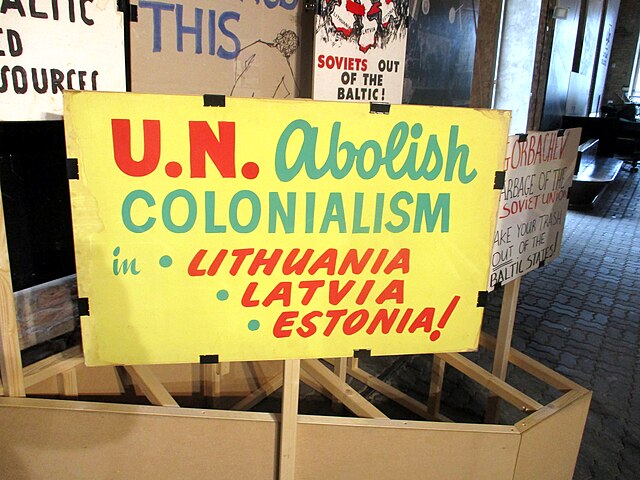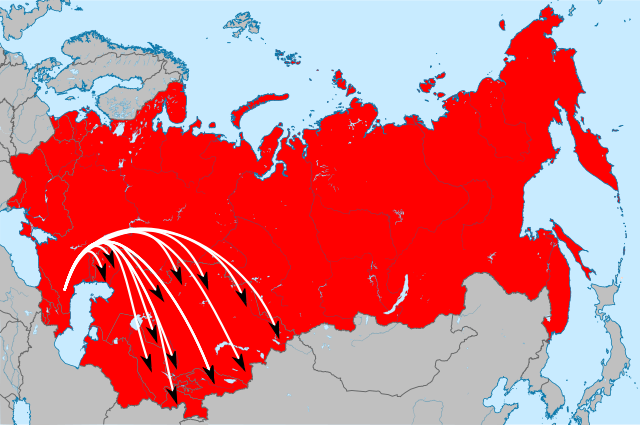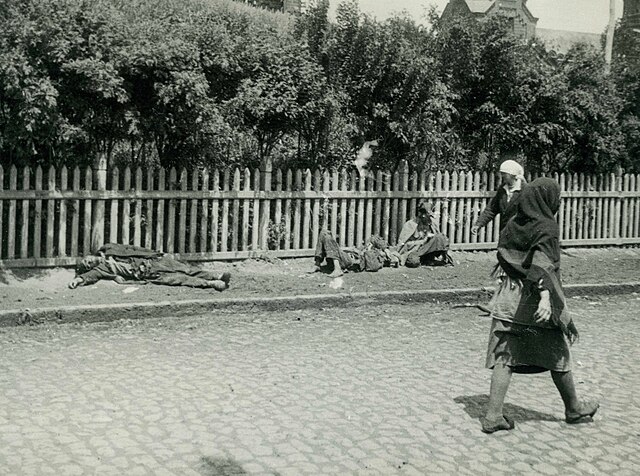Double genocide theory
comparison of Soviet atrocities against Eastern Europeans to the Holocaust From Wikipedia, the free encyclopedia
Remove ads
The double genocide theory (Lithuanian: Dvigubo genocido požiūris, lit. 'Double genocide approach') says that two equally serious genocides happened in World War II. The first was the Holocaust committed by Nazi Germany against Jews.[1][2] The other was a genocide committed by the Soviet Union against Eastern Europeans (including the Poles, Ukrainians, and Baltic states' population), according to this theory.[3]
Remove ads
Overview
Historians think that the double genocide theory appeared in Lithuania after the Soviet Union ended in December 1991.[3] After this, formerly Soviet-occupied countries built monuments and museums to show the world the evidence of their suffering under Soviet totalitarianism.[3]


Supporters of the double genocide theory base their views on a series of events that happened in Soviet-occupied countries. The theory is controversial among scholars worldwide.[3] Some say that the double genocide theory is a form of historical revisionism.[3]

Remove ads
Soviet persecution of Poles
Josef Stalin's Soviet forces killed at least 150,000 Poles on Polish soil in wartime.[6] Soviet persecution of the Poles continued until the Soviet puppet government in Poland fell in 1989.[7]

The Great Terror
During the Great Terror (also called the Great Purge) between 1936-1938, Stalin's forces killed 111,091 Poles living in or near the Soviet Union.[8][9]
Soviet-occupied Poland
In 1939, Nazi Germany and the Soviet Union invaded Poland and divided it in two.[10][11] The Soviet Union occupied eastern Poland. Stalin claimed he did this because pre-war Poland was a "crime against revolution [... with] counter-revolutionary activity".[12] Meanwhile, Nazi Germany occupied western Poland.
Soviet-occupied Poland included 52.1% of pre-war Poland (c. 200,000 km2) and over 13,700,000 citizens.[13] Among its citizens who were not Poles, 37% were Ukrainians, 14.5% Belarusians, 8.4% Jews, 0.9% Russians, and 0.6% Germans.[13]
In late June 1941, the Nazi-led Axis powers invaded the Soviet Union.[10][11] By that time, Soviet forces had already arrested 500,000 Poles in the Kresy macroregion.[6]
Katyn massacre
In a memo on March 5, 1940, Lavrentiy Beria asked Stalin to order the execution of 25,700 Polish "nationalists and counterrevolutionaries" in the Soviet-occupied zone.[14] Six members of the Soviet Politburo – Stalin, Vyacheslav Molotov, Lazar Kaganovich, Kliment Voroshilov, Anastas Mikoyan, and Mikhail Kalinin – signed an order authorizing this mass execution.[14]

Between April and May 1940, the Soviets executed around 22,000 Poles in the Katyn forest (now in Smolensk, Russia).[15][16] Most victims were captured Polish soldiers, Polish police, or members of the intelligentsia.[15][16]


Between February 10, 1940 and June 1941, as many as 1,200,000 Poles were deported to mainland Russia.[17] The deportation happened while Polish and Jewish property across the occupied zone were taken away by the Soviets.[18] Polish Jews made up 30% of the Poles deported to Siberia,[19][20] making them statistically the most targeted group among the deportees.[19][20]
The Katyn massacre was part of the Soviets' campaign to erase Poland's culture and identity.[15][16] The Soviets thought the Poles were "avowed enemies of Soviet authority", according to German-American historian Gerhard Weinberg.[21] Weinberg also wrote:[21]
Stalin could be certain that any revived Poland would be unfriendly [. ...] depriving it of a large proportion of its military and technical elite would make it weaker.
Destruction of Polish society
In both the Nazi- and Soviet-occupied zones, Poles were oppressed because of anti-Polish racism[11][22] (also called anti-Polonism[23] or Polonophobia[24]). This racism was not new; it existed even before the Soviet Union did.[22][25]
In their zone, the Soviets forced Russian culture onto the Poles. They made Polish universities focus on Russian studies, suppress Polish studies, and teach according to Soviet rules (called the Statute Books for Soviet Higher Schools).[13] They systematically erased traces of Polish history.[13] They dissolved all Polish political parties and organizations.[13] They also made the Polish currency invalid,[13] which caused the whole population to lose their life savings overnight.[26]
NKVD prisoner massacres
Before June 1941 (when Nazi Germany invaded the Soviet Union), the Soviets were holding hundreds of thousands of political prisoners in NKVD prisons across its occupied Eastern European territories.[27] Right after the invasion began, the NKVD was ordered to kill or evacuate 140,000 prisoners from Soviet-occupied eastern Poland.[27]
The NKVD hastily killed two-thirds of these prisoners.[27] Among the victims, at least 9,800 were reportedly executed in prisons and 1,443 executed during evacuation.[27] Geographically, 20,000–30,000 of them died in Soviet-occupied eastern Poland. Around 9,000 died in the Ukrainian SSR,[27] which had just gone through the Holodomor[28][29] and Great Purge-related massacres in the 1930s.[30][31] They were targeted for mass murder over their Polish or Ukrainian identity.[27][31]
Historian Yury Boshyk wrote:[30]
It was not only the numbers of the executed, but also the manner in which they died that shocked the populace. When the families of the arrested rushed to the prisons after the Soviet evacuation, they were aghast to find bodies so badly mutilated that many could not be identified. It was evident that many of the prisoners had also been tortured before death; others were killed en masse.
Soviet puppet state in Poland
After Nazi Germany was defeated, the Soviet Union set up a puppet state in Poland.[32] Around 25,000 Polish Home Army soldiers[33] were deported to Gulags in mainland Russia.[33] Soviet soldiers also raped as many as 100,000 Polish women right after the war.[34]
The Soviet Union ruled Poland with communist totalitarianism until 1989,[35][36] and Soviet troops did not leave Poland until 1993.[37]
Polish resistance
Some anti-communist Poles fought against the Soviets.[38] However, the armed resistance failed because it had no support from foreign countries.[38] Tens of thousands of Polish resistance members were deported to mainland Russia.[38] The victims included around 6,000 Poles who had been jailed in Borowicze (now Borovichi, Russia) and another 6,300 in Stalinogorsk (now Novomoskovsk, Russia).[38]
Most were sent to Gulags in Workutstroj,[39] Pieczorłag, or Uchtiżemłag, located in the Komi Autonomous Soviet Socialist Republic in northwestern Russia.[38] Historians cannot tell exactly how many died, because nobody has access to all of the Soviet documents.[38] Just a few survived, at most.[38]
The Poles resisted the Soviet puppet regime throughout the Cold War, often peacefully. The government often used violence, arrests, and police brutality to respond to protests, even peaceful ones.[40][41] However, strikes and protests by the Polish people contributed to the fall of the puppet regime in 1989.[7]
Polish resistance efforts included:
- Protests in June 1956 in Poznań (c. 100 killed and 600 wounded)[40]
- Protests in March 1968[36]
- Protests in December 1970 (44 killed, 1,000+ wounded and 3,000+ arrested)[41]
- Strike actions in 1971 and June 1976[42] in Łódź[43]
- Strikes in 1980 in Lublin[44]
- A warning strike[45] and hunger demonstrations[46] in 1981
- Demonstrations in 1982[47]
- Strikes in 1988[7]
Remove ads
Soviet persecution of Baltic states' population
The Baltic states also suffered under both the Nazis and the Soviets.[48] Under Nazi occupation, Estonia lost 25% of its pre-war Jewish population,[49] Latvia lost 75%,[50] and Lithuania lost over 95%.[51][52]
1940–41
The Soviets first occupied the Baltic states between June 1940 and June 1941.[53] During that time, they deported around 124,467 people to mainland Russia.[53] The deportees included modern Latvia's founder, Kārlis Ulmanis (1877 – 1942); he died of dysentery in a Gulag in Soviet Turkmenistan.[54] Baltic states' soldiers who refused to join the Red Army were shot.[55][56] More were arrested and deported by the NKVD.[55][56]
Historian Robert Conquest called these selective deportations a policy of "decapitation" by killing off Polish elites, "as was later evidently to be the motive for the Katyn massacre [in which about 22,000 Poles were killed]".[57] Meanwhile, Estonians and Latvians viewed this deadly year as the "year of horror".[55][56]
1941–44
Many Estonians, Latvians, and Lithuanians accepted the Nazi takeover.[55][56] They did not know that the Holocaust was happening, and they viewed the Nazis as the only alternative to the oppressive Soviets.[55][56] By July 1944, the Nazis had forced 160,000 people in occupied Latvia to fight for Adolf Hitler by July 1944.[55][58] In Nazi-occupied Lithuania, they conscripted at least 20,000 people.[58][59]
Though the Nazis had forced these people to fight, they claimed the conscripts were volunteers.
1944–91

After World War II ended, the Soviets re-took control of the Baltic states. Between 1944 and 1956, many Baltic people resisted Soviet ethnic cleansing and totalitarianism.[60][61] In response, the Soviets deported at least 505,000 people from the Baltic states to Gulags in mainland Russia (including 124,000 Estonians, 136,000 Latvians, and 245,000 Lithuanians).[48] The Baltic states lost 20% of their total population as a result.[48] This included 250,000 who people who fled to Western countries to escape the Soviets.[48]
To scare the local people into obeying them, the Soviets would sometimes kill resistance members and dump their bodies in local villages.[63] On October 15, 1956, Adolfas Ramanauskas ("Vanagas"), chief commander of the Union of Lithuanian Freedom Fighters,[63] released a report describing the tortures some of them had suffered:[63][64]
The right eye is covered with haematoma [a bruise], on the eyelid there are six stab wounds made, judging by their diameter, by a thin wire or nail going deep into the eyeball. Multiple haematomas in the area of the stomach, a cut wound on a finger of the right hand. The genitalia reveal the following: a large tear wound on the right side of the scrotum and a wound on the left side, both testicles and spermatic ducts are missing.
Colonization during the Cold War
The Soviet regime imported millions of colonizers into the Baltic states from other parts of the Soviet Union.[65] This changed the Baltic states' ethnic composition forever:[65]
The occupied Baltic states did not benefit from the decades-long Soviet colonization; they were exploited by it.[68] Declassified archives show that the Soviets took much more money from the occupied Baltic states than they ever invested back.[68] They used huge amounts of this money for military infrastructure to oppress the native population.[68] The myth of "generous Soviet aid in developing the Baltics" is propaganda invented to justify Soviet colonization, under which the Baltic states went through decades of oppressive rule.[68]



Remove ads
Deportations of Chechens and Ingush

After the Soviets retook the part of Chechnya previously occupied by Nazi Germans, they mass-deported Chechen and Ingush people from the Northern Caucasus. They falsely accused these people of collaborating with the Nazis.[69] The Soviets forced as many as 400,000 Chechens and 91,250 Ingush from the area within 8 days.[69]
Fearing that the area's mountainous terrain favors guerrilla war, the Soviets entrapped the Chechens and Ingush by inviting them to join the Red Army Day celebrations on February 23, 1944.[69] Once they showed up, they were arrested by soldiers armed with machine guns.[69] The Chechen and Ingush deportees were sent to camps across Central Asia and Siberia.[69] They were not allowed to return to Chechnya until 1957.[69]
The Chechens and Ingush lost as much as 33% of their total pre-war population under the Soviet invasion.[70] This is around the same percentage of population that Cambodia lost during the Cambodian genocide (1975‒79) under the pro-Soviet Khmer Rouge regime.[71]
Remove ads
Debates about the double genocide theory
Dovid Katz
American Yiddish scholar Dovid Katz wrote that the double genocide theory is a form of Holocaust revisionism. He thought the theory resulted from a "recent initiative that seeks to create a moral equivalence between Soviet atrocities committed against the Baltic region and the Holocaust in European history".[72]
Michael Shafir
Romanian-Israeli political scientist Michael Shafir shared Dovid Katz's views.[73] He said the double genocide theory was partly "competitive martyrdom".[73]
Timothy Snyder
American historian Timothy Snyder discussed the double genocide theory in his 2010 book Bloodlands: Europe Between Hitler and Stalin. Some left-wing scholars, including Dovid Katz and Efraim Zuroff,[74] have accused Snyder of "suggesting a moral equivalence between Soviet mass murders and the Nazi Holocaust". In response, Snyder said:[75]
I coincide with Zuroff and Katz on the centrality of the Holocaust, but we must not overlook how Stalin enabled Hitler's crimes.
While accusing Snyder of trivializing the Holocaust, Zuroff himself denied the Holodomor[76][28] and Bosnian genocide,[77] despite the International Court of Justice (ICJ) and the International Criminal Tribunal for the former Yugoslavia (ICTY) having ruled that the Bosnian genocide was indeed a genocide.[78][79]
In addition, scholars who hold similar views to Zuroff often accuse the NATO of "inventing" the Bosnian genocide to justify the bombing and "destruction" of Yugoslavia,[78][79] or blame the Bosnian genocide victims for their own suffering.[78][79] The leading Bosnian genocide deniers include but not limited to Michael Parenti, Edward S. Herman, David Peterson, Jared Israel, Tariq Ali, Mick Hume and Diana Johnstone,[78][79] most of whom also reject the double genocide theory.[78][79]
James Kirchick
In a review of Snyder's book, American reporter James Kirchick said that Western intellectuals do not pay much attention to the Holodomor because of "the machinations of that [Soviet] regime in crafting the internationally agreed-upon legal definition of the term [genocide]".[80]
While the United Nations were drafting the Convention on the Prevention and Punishment of the Crime of Genocide, the Soviets reportedly prevented "social" and "political" groups from being included in the list of possible genocide victims.[80] This kept the Soviets' crimes from being classified as genocide.[80] The victims belonged to several ethnic groups randomly labelled as "reactionary" or "counterrevolutionary", who were killed until Stalin chose to stop.[80]
Kirchick defended Snyder against accusations that he was "minimizing the Holocaust".[80] Snyder documented Nazi and Soviet atrocities equally, Kirchick said.[80] He also wrote that Stalin enabled Hitler's war in Europe by:[80]
- Making Soviet communism absolutist and totalitarian; this allowed Hitler to justify militarizing German society to confront the Soviet Union
- Telling the German communists to treat the Social Democratic Party as "social fascists"; this divided the left-wing Germans who could have prevented the Nazi takeover
- Signing the Molotov-Ribbentrop pact
- Invading Poland and occupying it until June 1941, when Hitler invaded the Soviet Union
Dovilė Budrytė
Dovilė Budrytė, a Lithuanian-American political scientist, wrote in 2016 that Ukrainians and Baltic people describe Soviet crimes with the word "genocide" as a form of "nation-building myths rooted in traumas".[81] She cited studies done by other scholars to support this theory.[82] She saw those views as "postcolonial trauma narratives".[81] She warned against any "unquestioning acceptance" of these ideas.[81]
In 2022, Russia invaded Ukraine. According to Budrytė, the Baltic states strongly support Ukraine because they have a shared history of suffering "genocides" under Soviet rule.[83]
She also wrote that people's lived experiences do not divide neatly between "Western" and "non-Western".[83] She highlighted the need to consider "power structures, broader political contexts and existing local and international norms" in order to judge how valid some of their claims are.[83]
Kristen Ghodsee
American ethnographer Kristen Ghodsee wrote about the double genocide theory in 2014. She had previously claimed that "East German women had better sex under communism".[84] She argued that "economic and political elites" promoted the double genocide theory because they "fear[ed] a leftist resurgence in the face of [...] extreme social inequalities [... and] the excesses of neoliberal capitalism".[85] She accused these "elites" of "focusing almost exclusively on Joseph Stalin's crimes" when discussing communism, and "linking all leftist ideals to the excesses of Stalinism".[85]
Remove ads
Debates about the Katyn massacre
Historians have debated whether the Katyn massacre ‒ a major Soviet war crime[17] ‒ could be called a genocide under the double genocide theory. Many Polish scholars have described the massacre as a genocide, including historian Adam Basak,[17][86] jurist Cezary Mik,[17][87] Karolina Kosińska,[17][88] and prosecutor Małgorzata Kuźniar-Plota,[17][89] who investigated the massacre.[17][89]
[The Soviet Politburo's] intent was to destroy a part of the Polish national group [...] twenty-six thousand representatives of the intellectual elite, selected because of their social status and social function.
Mik called the massacre "genocidal murder of the Polish elite in Katyn and other places".[17][87]
If we talk about a specific plan to destroy a group, we can undoubtedly point to the USSR's policy [. ...] various genocidal acts against the Polish nation, acts the most spectacular of which was the Katyn Massacre.
More importantly, Kuźniar-Plota,[17][89] who investigated the massacre,[17][89] ruled that:[17][89]
[The Katyn massacre] had all the characteristics of the crime of genocide specified in Article 2 of the Convention on the Prevention and Punishment of the Crime of Genocide.[90]
Remove ads
Debates about the Holodomor


Some scholars who debate the double genocide theory discuss the Holodomor.[28][29] This was a man-made famine in Soviet Ukraine between 1932-1933.[28][29] As many as 7,000,000 people died of starvation under Stalin's policies.[28][29] As of 2025, over 30 countries recognize that the Holodomor was a genocide against the Ukrainian people:[91]
Many Western scholars who reject the double genocide theory have denied the Holodomor.[92][93] This denial comes from communist sympathies, which prevent them from recognizing the worth of Ukrainians as equal humans, according to other scholars.[92][93]
Holodomor denial is considered racist and dehumanizing.[92][93] Jurij Dobczansky, a senior Library of Congress cataloging specialist,[94] said:[95]
Holodomor denial [...] consists of especially vitriolic anti-Western and anti-Ukrainian tirades [...] accusations of foreign influence and Nazi sympathies, or ulterior motives.
Remove ads
Related pages
References
Wikiwand - on
Seamless Wikipedia browsing. On steroids.
Remove ads